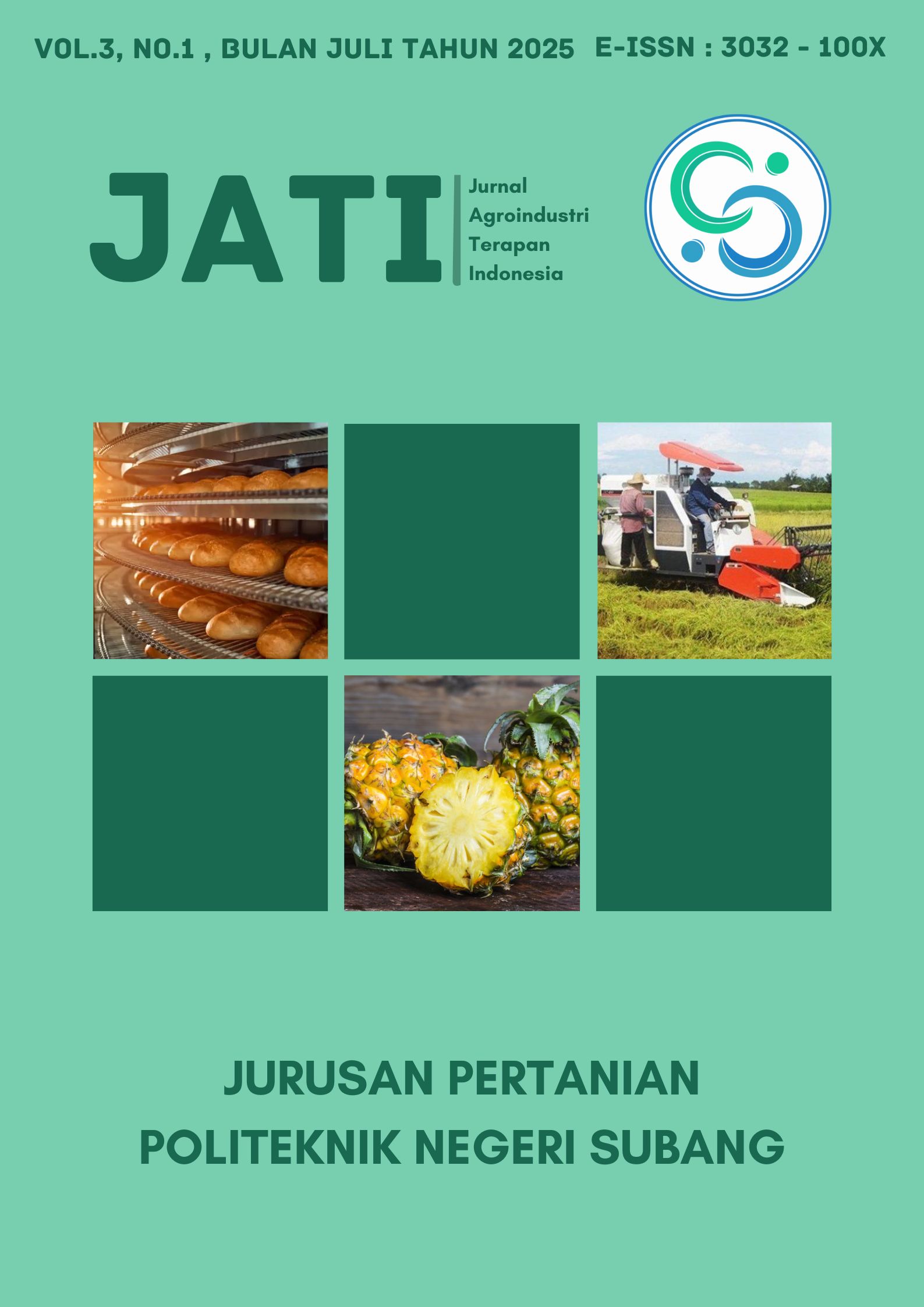INDIKATOR ALAMI BERBASIS EKSTRAK DAUN ERPA (Aerva sanguinolenta) UNTUK DETEKSI BORAKS DALAM PRODUK PANGAN
Natural Indicator from Aerva sanguinolenta Leaf Extract for Borax Detection in Food Products
Main Article Content
Abstract
Aerva sanguinolenta leaves contain anthocyanis that can be utilized as a borax detector in food products. This study aimed to determine the charateristics of Aerva sanguinolenta leaf extract and evaluate its effectiveness as a natural color indicator for borax detection. The research employed a Completely Randomized Design (CRD) with four treatments of borax concentrations (0%, 1%, 2%, and 3%) with three replications. The paramaters observed included the yield and pH of the extract, as well as the reaction of the extract and the natural color indicator when exposed to varying borax concentration treatments. Data were analyzed using ANOVA and followed by DMRT at a 5% significance level. The result showed that the leaf extract yield was 79% with a pH of 4,93. The extract reacted positively to borax, producing varying color intensities across treatments. The natural color indicator reacted with borax and exhibitied significant differences (P<0,05) in red and yellow color parameters. The higher the borax concentration resulted in darker indicator color, indicating that natural color indicator from Aerva sanguinolenta leaves are effective for borax detection.
Article Details

This work is licensed under a Creative Commons Attribution-NonCommercial-ShareAlike 4.0 International License.
References
Anik, E. N., & Zidni, A. B. (2018). Pemanfaatan Ekstrak Antosianin dari Bunga Kembang Sepatu (Hibicus-rosa sinensis. L) sebagai Indikator untuk Identifikasi Boraks. Jurnal Sains , 4(16).
BPOM. (2019). Peraturan Badan Pengawas Obat dan Makanan Nomor 11 Tahun 2019 tentang Bahan Tambahan Pangan.
Du, H., Wu, J., Ji, K. X., Zeng, Q. Y., Bhuiya, M. W., Su, S., Shu, Q. Y., Ren, H. X., Liu, Z. A., & Wang, L. S. (2015). Methylation mediated by an anthocyanin, O-methyltransferase, is involved in purple flower coloration in Paeonia. Journal of Experimental Botany, 66(21), 6563–6577. https://doi.org/10.1093/jxb/erv365
Earnestly, F., Firdaus, Muchlisinalahuddin, Muharni, R., & Leni, D. (2023). Pengenalan Bahaya Boraks dalam Makanan Bagi Kesehatan Pada Ikatan Keluarga Kotolaweh Kota Padang. Jurnal Salingka Abdimas, 3(1), 191–197.
Esati, N. K., & Cahyadi, K. D. (2023). Uji Kualitatif Boraks dengan Indikator Alami Serta Analisi Kuantitatifnya Secara Spektrofotometer UV-VIS. Jurnal Farmasetis, 12(4), 373–382.
Fatoni, A., Rusli, D., Wahyuni, Y. S., Sari, Y. R., Amelia, K., Imanda, Y. L., & Hidayati, N. (2025). Penyuluhan dan Demonstrasi Prinsip Dasar Deteksi Senyawa Kimia Berbahaya Boraks Serta Ikatan Kimianya dengan Bahan Alam Kulit Buah Naga Merah dan Kunyit di SMA N 1 Sungai Rotan Muara Enim, Sumatera Selatan. Jurnal Kreativitas Pengabdian Kepada Masyarakat (PKM), 8(4), 2051–2060. https://doi.org/10.33024/jkpm.v8i4.18723
Fauzi, R. A., Widyasanti, A., Dwiratna, S., Perwitasari, N., & Nurhasanah, S. (2022). OPTIMASI PROSES PENGERINGAN TERHADAP AKTIVITAS ANTIOKSIDAN BUNGA TELANG (Clitoria ternatea) MENGGUNAKAN METODE RESPON PERMUKAAN Optimization of Drying Process on Antioxidant Activity of Butterfly Pea (Clitoria ternatea) by Using Response Surface Methodology. In Jurnal Teknologi Pertanian (Vol. 23, Issue 1).
Gupta, P., Jain, P., & Jain, P. K. (2012). Dahlia Flower Sap : A Natural Resource As Indicator In Acidimetry And Alkalimetry. International Journal of ChemTech Research, 4(4), 5038–5045.
Handayani, S. S., Gunawan, E. R., Suhendra, D., & Murniati, M. (2024). Kajian Pengaruh Suhu Pemanasan Awal Dan Waktu Sokletasi Terhadap Perolehan Minyak Biji Kelor (Moringa Oleifera Lam.). Jurnal Sains Teknologi & Lingkungan, 10(4), 749–754. https://doi.org/10.29303/jstl.v10i4.754
Heryanto, I., Irmansyah, T., & Sinurat, M. (2020). Respon Pertumbuhan Stek Sambang Colok (Aerva sanguinolenta L.) Terhadap Pemberian Tiga Sumber Zat Pengatur Tumbuh. Jurnal Online Agroekoteknologi , 8(2), 95–102. https://doi.org/10.32734/jaet
Judijanto, L., Winiastri, D., Jufri, N., Jairani, E. N., Pratiwi, G., Irwanto, R., Triastuti, D., Zahra, Galia, M. A., Ilmidin, Ridwan, W., Triandita, N., & Latifah, N. (2025). Keamanan Pangan dan Water Safety PLlan (A. S. Nasution, Ed.; 1st ed., Vol. 1). Future Science Publisher.
Kemenkes RI. (1988). Peraturan Menteri Kesehatan Republik Indonesia No. 722/Menkes/Per/IX/1988 tentang Bahan Tambahan Makanan.
Octaviani, D. Y., Nugroho, T. T., & Dahliaty, A. (2020). Penentuan Total Konsentrasi Antosianin dari Ubi Jalar Ungu (Ipomoea batatas L.) dengan Metode pH Differensial Spektrofotometer. 1–8.
Puspita, D., Tjahyono, Y. D., Samalukang, Y., Im Toy, B. A., & Totoda, N. W. (2018). Produksi Antosianin Dari Daun Miana (Plectranthus Scutellarioides) Sebagai Pewarna Alami. . Pro Food, 4(1), 298–303.
Suharyani, I., Rohadi, D., Kunaedi, A., Arisandi, D., Hasim, I., Shafa Fauziah, R., Jullinar, S., Tinggi Farmasi Muhammadiyah Cirebon, S., Cideng Indah No, J., & Barat, J. (2021). Review: Berbagai Metode Analisis Kualitatif dan Kuantitatif Boraks dalam Sampel Makanan. Review: Berbagai … Journal of Pharmacopolium, 4(3), 174–179.
Triastuti, D., Suciati, F., & Putri, D. P. (2024). The Potential of Subang Pineapple Peel Waste as Biovinegar. Agroindustrial Technology Journal, 8(2), 17–30. https://doi.org/10.21111/atj.v8i2.12746
Warsiki, E., Nofrida, R., & Yuliasih, I. (2013). Pemanfaatan Ekstrak Daun Erpa (Aerva sanguinolenta) untuk Label Cerdas Indikator Warna (The Use of Erpa (Aerva sanguinolenta) Leaf Extract as Colour Indicator Smart Label). In Jurnal Ilmu Pertanian Indonesia (JIPI) (Vol. 18, Issue 1).
